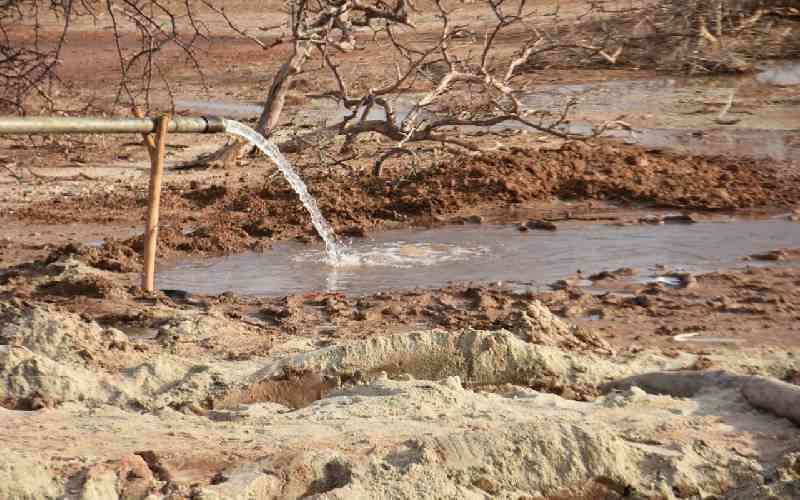It is not unusual to hear stories of families in Nairobi who, due to high costs and erratic supply of water, have resulted to taking showers thrice a week, flashing toilets once a day and washing clothes only if necessary. In the city of Nairobi, it is also not unusual to see cart vendors with 20 litre Jerricans supply water even in suburbs. The cost of water has become unaffordable especially in areas where supply is low a Jerrican retails at averagely Sh50. There is no dignity in living like this where access and affordability of public essential goods like water is a myth. This is definitely not what Article 43 of the Constitution is all about.
The world commemorated the World Water Day yesterday with the theme “Leaving no one behind.” This is the principle and central promise of agenda 2030. As this unfolds, the Joint Monitoring Programme (JMP 2017) report by World Health Organisation and Unicef on progress towards water, sanitation and hygiene indicates that 844 million people still lack basic drinking water services, 263 million people spent more than 30 minutes per round trip to collect water from a safe source and 159 million still collect drinking water directly from surface water sources (unimproved or unsafe) of which 58 per cent is from Sub-Saharan Africa.
In Kenya, the right to clean, safe, adequate, sufficient and quality water and standard sanitation is guaranteed for all under Article 43 of the Constitution 2010. According to WaterServices Regulatory Board (Wasreb) Impact 10 report of 2018, Kenya’s water coverage was at 55 per cent while sewerage coverage was at 16 per cent. The World Bank places national sanitation coverage at 30 per cent. The Kenya Environmental Sanitation and Hygiene Policy (2016-2030) underscores these statistics and further identifies worrying discrepancies between rural and urban areas as well as the formal and informal urban areas. The Wasreb report further articulates that access to water in urban areas is highly unequal and unfair. This contradicts and contravenes the “leaving no one behind” ambition.
Kenya has demonstrated commitment to realise the aspirations of the SDGs by launching and domiciling the agenda into government plans, policies and budgets. With this in focus, two components crucial to the realisation of SDGs targets are (1) disaggregated data and facts right from the baseline to support and inform the planning and monitoring process and (2) partnerships and collaboration anchored on mutual accountability from all the stakeholders. This will ensure each partner accepts responsibility and commits to be held accountable for their commitments. These are essential and paramount to fast-track goal 6 and its targets.
Delving deeper into mutual accountability, this is simply a process through which two or more partners agree to be held accountable and responsible for the commitments that they voluntarily made/make to each other based on common goals or objectives or an agenda. It is more concerned with collective results that are progressive rather than punitive conditions and implications for noncompliance. Mutual accountability embraces human rights by acknowledging government as a duty bearer and placing the leadership responsibility on the state.
As a country, mutual accountability has the potential of advancing access to water and sanitation while addressing the inequalities. It will also play a significant role in promoting good sector governance by promoting transparency and meaningful utilisation of public resource and further establish open dialogue platforms to address the water and sanitation challenges.
For Kenya to realise SDGs and access to safe water for all, we must move beyond packaging water challenges as statistics or a subject for discussion in international conferences. We need action in urban and rural areas. Nairobi County must strive to improve the quality of living through fixing water supply and infrastructure. We are tired of the same old excuses of cartels and so forth, government should address systemic issues around water supply and demand conclusively.
- The writer is Programme Officer Health Water and Sanitation at Hakijamii
 The Standard Group Plc is a
multi-media organization with investments in media platforms spanning newspaper
print operations, television, radio broadcasting, digital and online services. The
Standard Group is recognized as a leading multi-media house in Kenya with a key
influence in matters of national and international interest.
The Standard Group Plc is a
multi-media organization with investments in media platforms spanning newspaper
print operations, television, radio broadcasting, digital and online services. The
Standard Group is recognized as a leading multi-media house in Kenya with a key
influence in matters of national and international interest.
 The Standard Group Plc is a
multi-media organization with investments in media platforms spanning newspaper
print operations, television, radio broadcasting, digital and online services. The
Standard Group is recognized as a leading multi-media house in Kenya with a key
influence in matters of national and international interest.
The Standard Group Plc is a
multi-media organization with investments in media platforms spanning newspaper
print operations, television, radio broadcasting, digital and online services. The
Standard Group is recognized as a leading multi-media house in Kenya with a key
influence in matters of national and international interest.









